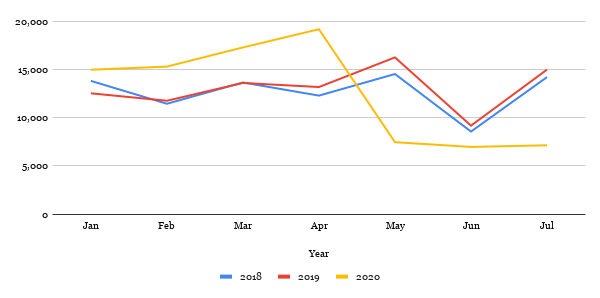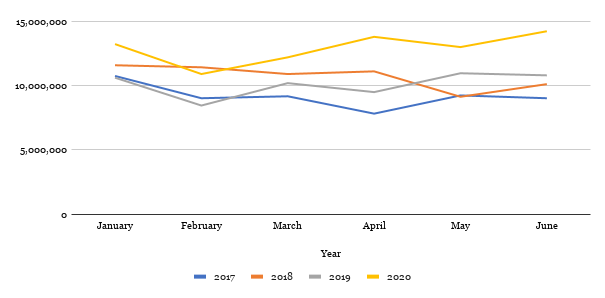In an article published by Indonesia-based Antara news, an Indonesian government official stated that Indonesia will bump up its L. vannamei export value by 250% from 2020 to 2024. With an estimated export volume of 168,000 MT L. vannamei in 2019 this would result in an export of around 420,000 MT L. vannamei in 2024. It’s not the first time that the Indonesian government and other industry stakeholders announce or predict rapid expansion. In this blog post, I will take you along Indonesia’s recent production and export performance and explore whether Indonesia indeed might become the next L. vannamei colossus.
38% EXPORT INCREASE FROM 2010-2019; INTENSIVE FARMING MAY ACCELERATE GROWTH
Since 2010, Indonesia’s overall shrimp exports fluctuated between 140,000 and 200,000 MT, of which L. vannamei accounted for 85% in 2019. After the previous peak of 185,000 MT in 2015, exports dropped to 170,000 MT in 2017 and subsequently increased to 194,000 MT in 2019. From 2010 to 2019, exports increased only by 38% − an average annual growth rate of 4%. Actual annual growth was −6%, 12% and 3% in 2017, 2018 and 2019 respectively. So I believe I have good reason to be a bit suspicious of Indonesia’s ambition.
Still, there are some considerations to take into account. The official announcing the government’s ambition also predicted that expansion of intensive shrimp farming, where farmers stock more than 200 PL/m2, would be the driver for growth. In a recent article by IntraFish, Cargill’s aquaculture director for Malaysia and Indonesia states his belief that Indonesia’s shrimp sector is at a tipping point and that intensive shrimp farming will support Indonesia in its rapid output growth over the next couple of years.
Production statistics show that in recent years shrimp farming expanded rapidly beyond the traditional farming hubs in Lampung and East Java. New farming clusters have developed in Sulawesi and the eastern parts of Indonesia, especially East Nusa Tenggara. Facebook pages used by Indonesian shrimp farmers regularly show photos of new intensive farms producing shrimp in different types of farming systems but all with very high densities. Future expansion may be expected from farmers located in these new production geographies, not from the many semi-intensive farms which are currently still responsible for the majority of Indonesia’s L. vannamei production.
Farms developed in these new geographies are often isolated from other farms and experience less disease pressure than traditional farming areas on Java and South Sumatra. I love browsing Google Maps to find those new farms hidden along the coastline. Satellite images give a good impression of production density, looking at pond design and especially the amount of aeration applied to the pond (see Figures 1 and 2).
Figure 1: Shrimp farm in South Sulawesi
Source: Google Earth
Figure 2: Shrimp farm in West Nusa Tenggara
Source: Google Earth
SULAWESI AND EASTERN INDONESIA EXPORTS INCREASE ALONG WITH PRODUCTION
Farming expansion in new farming regions is supported by BKIPM’s export data based on the location where health certificates for exports have been issued. If we look at 2018-2020 growth (comparing January-July for each year), we see that exports from East and West Java dropped from 2018 to 2020 by respectively 25% and 20%. Exports from South Sumatra including Lampung only increased moderately: 11% from 2018 to 2019. Meanwhile, exports from South Sulawesi more than tripled and exports from Central Sulawesi doubled. Exports from Maluku and West Nusa Tenggara popped up out of nowhere to 4,500 and 3,800 MT in 2020 respectively.
These export figures show that not only production but also export grows beyond the traditional hubs, indicating processing capacity expansion in these new geographies. However, in 2020, East and West Java (62%) and South Sumatra (11%) still account for the majority of exports in absolute terms. Production has already expanded to Sulawesi and Indonesia’s eastern islands, and exports are likely to follow soon.

2020 STARTED OFF STRONG BUT EXPORTS DROPPED AFTER RAMADAN
Indonesian exports usually peak towards the start of Ramadan and increase again after the Ramadan holidays. With Ramadan starting on 23 April this year, exports indeed dropped between April and May but, contrary to other years, didn’t recover once Ramadan holidays were over. This was clearly a result of the lockdown and travel restrictions due to the Covid-19 pandemic, causing logistical challenges in Indonesia and distorting the international market.
Figure X: Indonesia’s L. vannamei exports in January-July 2018-2020

Note: BKIPM obtained these data, which are continuously reported and contain the volume of L. vannamei which was pre-shipment tested and provided with a health certificate for exports.
The increase of exports from Indonesia is also supported by US shrimp import data from the National Oceanic and Atmospheric Administration (NOAA). While these figures may include some volume of P. monodon and wild-caught shrimp, the vast majority is accounted for by L. vannamei. NOAA’s data show that Indonesia’s exports to the US in the first half of 2020 outperformed 2019 by 27% and even grew 41% compared to 2017.
Figure X: US shrimp imports from Indonesia in January-June 2017-2020

Source: NOAA
The drop in Indonesia’s export figures reported by BKIPM will likely be reflected in NOAA’s import data on July. In April 2020, when exports almost reached 20,000 MT, the US accounted for 70% of L. vannamei exports. Meanwhile, China and Japan accounted for 9% and 8% respectively. This should give you an idea of the importance of the US for Indonesia’s exports.

DESPITE POSSIBLE MOMENTUM, 250% GROWTH BY 2024 SEEMS AMBITIOUS
The increase of exports over the first months of 2020 was significant and possibly a result of the expansion of intensive shrimp farms in several parts of Indonesia. It remains to be seen whether L. vannamei exports recover once Covid-19 restrictions have been lifted, or whether market conditions discourage Indonesian shrimp farmers to continue their production expansion.
While 2020 showed some positive signs, data of previous years don’t yet make me foresee a 250% shrimp export growth. However, if 2020’s pre-Covid-19 exports were a sign of the expansion of super-intensive shrimp farming, Indonesia might end up increasing its output significantly over the next couple of years and become a more prominent competitor for other shrimp producers in the region.